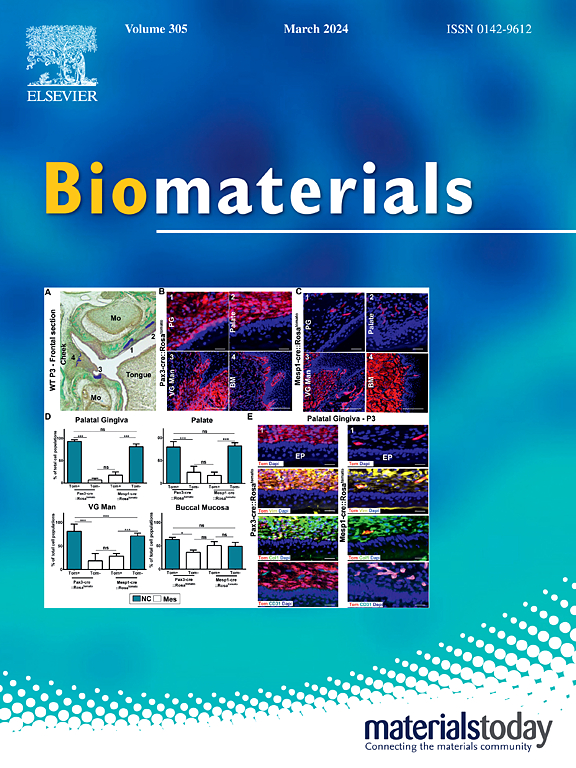“Sandwich” structured nanorods for timely antibiosis, immunoregulation and neuroangiogenesis to accelerate osteogenesis of Zn-based implants in diabetics
IF 12.9
1区 医学
Q1 ENGINEERING, BIOMEDICAL
引用次数: 0
Abstract
Pathological microenvironment of diabetes predisposes to induce bacterial infection, sustained inflammatory response, and impaired neuroangiogenesis, impeding fracture repair. Zn-based implants have great potential to replace conventional Ti implants as temporary fixations, but their osseointegration ability needs improvement. In this work, “sandwich” structured nanorods were constructed on Zn substrate with ZnO nanorods as core, riboflavin-encapsulated ZIF-8 as intermediate layer and HA as outer shell. Under normal physiological condition, ZIF-8 and HA reduce degradation of Zn substrate, decreasing Zn2+ release. ZIF-8 and riboflavin scavenge extracellular and intracellular ROS, respectively, achieving antioxidant therapy and establishing anti-inflammatory microenvironment via promoting M1 macrophages to polarize toward M2 phenotype. The synergistic effect of Zn2+, riboflavin as well as cytokines secreted by macrophages up-regulates the vitality and biological functions of BMSCs, HUVECs and PC-12 cells in vitro. When bacteria invade, they secrete hyaluronidase and organic acids to decompose HA and ZIF-8 sequentially, releasing a mass of Zn2+, which increases bacterial membrane permeability and induces intracellular ROS production and protein leakage, leading to bacterial death. The comprehensive effects of the “sandwich” structured nanorods on antibiosis, anti-inflammatory and neuroangiogenesis to accelerate osseointegration are further confirmed in an infected diabetic model, exhibiting great promise for Zn-based implants in clinical application.

“三明治”结构纳米棒用于及时抗生素、免疫调节和神经血管生成,以加速糖尿病患者锌基植入物的成骨
糖尿病的病理微环境易诱发细菌感染、持续炎症反应和神经血管生成受损,阻碍骨折修复。锌基种植体替代传统钛种植体作为临时固定体具有很大的潜力,但其骨整合能力有待提高。本文以ZnO纳米棒为核心,核黄素包封的ZIF-8为中间层,透明质酸为外壳,在Zn衬底上构建了“三明治”结构的纳米棒。在正常生理条件下,ZIF-8和HA降低了Zn底物的降解,降低了Zn2+的释放。ZIF-8和核黄素分别清除细胞外和细胞内ROS,通过促进M1巨噬细胞向M2表型极化,实现抗氧化治疗和建立抗炎微环境。巨噬细胞分泌的Zn2+、核黄素和细胞因子协同作用上调BMSCs、HUVECs和PC-12细胞的体外活力和生物学功能。细菌入侵时,分泌透明质酸酶和有机酸,依次分解HA和ZIF-8,释放大量Zn2+,增加细菌膜通透性,诱导细胞内ROS生成和蛋白质渗漏,导致细菌死亡。在感染的糖尿病模型中,进一步证实了“三明治”结构纳米棒在抗生素、抗炎和神经血管生成方面的综合作用,加速了骨整合,显示了锌基种植体在临床应用中的巨大前景。
本文章由计算机程序翻译,如有差异,请以英文原文为准。
求助全文
约1分钟内获得全文
求助全文
来源期刊

Biomaterials
工程技术-材料科学:生物材料
CiteScore
26.00
自引率
2.90%
发文量
565
审稿时长
46 days
期刊介绍:
Biomaterials is an international journal covering the science and clinical application of biomaterials. A biomaterial is now defined as a substance that has been engineered to take a form which, alone or as part of a complex system, is used to direct, by control of interactions with components of living systems, the course of any therapeutic or diagnostic procedure. It is the aim of the journal to provide a peer-reviewed forum for the publication of original papers and authoritative review and opinion papers dealing with the most important issues facing the use of biomaterials in clinical practice. The scope of the journal covers the wide range of physical, biological and chemical sciences that underpin the design of biomaterials and the clinical disciplines in which they are used. These sciences include polymer synthesis and characterization, drug and gene vector design, the biology of the host response, immunology and toxicology and self assembly at the nanoscale. Clinical applications include the therapies of medical technology and regenerative medicine in all clinical disciplines, and diagnostic systems that reply on innovative contrast and sensing agents. The journal is relevant to areas such as cancer diagnosis and therapy, implantable devices, drug delivery systems, gene vectors, bionanotechnology and tissue engineering.
 求助内容:
求助内容: 应助结果提醒方式:
应助结果提醒方式:


